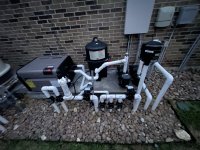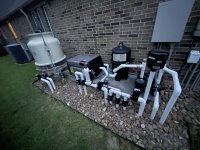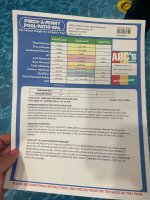It also looks like you are using chlorine tabs for chlorination. Over time, this will cause your CYA level to get too high. High CYA means you need much more chlorine to maintain or shock your pool. Tabs are fine for vacation or short periods, but trying to use them as your only source of chlorination will lead to tears.
Personally, I would not add any stabilizer, and just let the Tri-Chlor tabs increase it (if we are to believe the pool store's test results). After a week or three, I'd switch to using liquid chlorine instead of tabs. Keep the tabs for vacation, they store just fine. Yes, you have to add it daily (or sometimes get away with every other day), but I wish someone had told me this the first year I owned the pool, rather than learning it hard way after 5 or 6 years.
My chlorine tab experience: Pool runs fine until ~mid-August (usually during the worst heatwave of the summer), then it turns green. and it takes multiple expensive shock treatments (shock it - still green - shock it again - still green - shock it again with 2x shock - now it's cloudy and doesn't clear - shock it again - still cloudy - oh, too much calcium hardness, replace some water - 2 weeks later, the pool is back in action, my wallet is much lighter and my kids are complaining because it's almost time to back to school). The pool store recommends the water exchange because the shock increased the hardness too high, but the reality is the stabilizer was too high, and there's no reason to use powdered shock vs liquid.
My only other question is why is your PH so high with Chlorine tabs. Tabs produce acid which lowers PH and you usually have to add stuff to lower PH. Do you have a water feature (aeriation will raise PH)?
I realize none of this has anything to do with the leaking pump. Look closely at the pump and see what areas are wet and which are not. The pump basket has a drain plug that could be leaking, or its possible water is seeping out if the cover is not completely sealed. Alternatively, there might be a bad plumbing connection with the pump. If the cement is wet, there is a drip somewhere, but it might be slow enough that it is hard to see.




